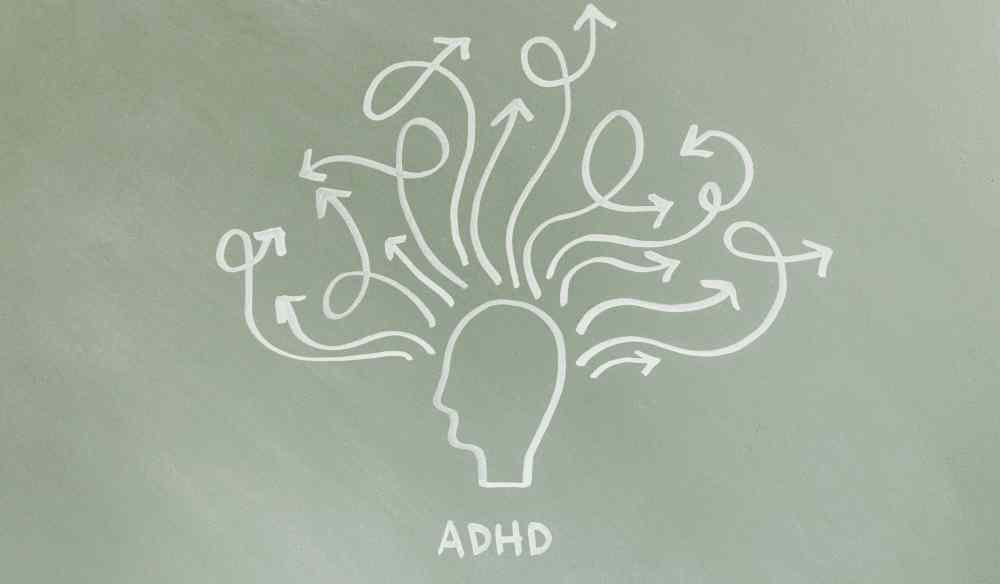We live in a world that demands our constant attention, for us to stay focused, and to continuously be on our toes, and many times we struggle to keep up with the pressures of our lives. This challenge becomes further intensified for individuals having Attention-Deficit Hyperactivity Disorder (ADHD). From classrooms to boardrooms ADHD brings along a unique set of obstacles in an individual’s personal, academic, and professional lives, that are tough to overcome.
Welcome to this blog about ADHD in which we will be covering the following points
- What is ADHD?
- Causes of ADHD.
- Clinical Presentation of ADHD
- Impact of ADHD on a child’s quality of life
- Treatment
What is ADHD?

Attention-deficit hyperactivity disorder (ADHD) is a neurodevelopmental disorder that affects millions of children and often continues into adulthood. Children and Adolescents diagnosed with ADHD usually demonstrate developmentally inappropriate levels of inattention, hyperactivity, or impulsivity, which are commonly associated with clinically significant impairments in academic and social functioning (Barkley, 2015).
ADHD is considered a debilitating and chronic (long-lasting) disorder that impacts an individual in different areas of their lives such as their social and interpersonal relationships, and academic and professional accomplishments, and can even hamper their day-to-day functioning (Harpin, 2005).
Causes of ADHD
The specific causes of ADHD have been widely debated. Similar to many other disorders, accessible evidence points to both genetic (Ilott et al., 2010; Sharp et al., 2009) and social-environmental factors (e.g., prenatal alcohol exposure; Ware et al., 2012) as potential causes of ADHD.
1. Genetic Factors
Genetic factors play a key role in the development of ADHD. Numerous twin, family, and adoption studies demonstrate an increased probability of ADHD among immediate family members of individuals having ADHD. Particular genes that affect how brain chemicals like dopamine work, such as those found in dopamine receptors and transporters, have been connected with a higher likelihood of having ADHD (Khan & Farone, 2006).
2. Neurobiological Factors
Our brain is like a giant puzzle made up of tiny pieces that are known as ‘neurons’. These neurons communicate with each other using messengers known as ‘neurotransmitters’ that tell your brain what it needs to do. Some of these neurotransmitters make you feel happy, others help you concentrate, and others control how your body moves.
Neurotransmitters in your brain such as Dopamine and Norepinephrine are essential to help regulate attention, make decisions, and control impulses. Neuroimaging studies have revealed that children having ADHD have some structural and functional differences in their brains that are associated with these functions (Hoogman et al., 2017, 2019).
3. Environmental Factors
Prenatal and perinatal factors can contribute to the development of ADHD. If the mother smokes, drinks alcohol, or uses drugs while the baby is in the womb, it might be associated with an increased likelihood of the child developing ADHD (Dong et al., 2018; Nilsen and Tulve, 2020). Other environmental factors that may contribute to this are low birth weight, premature birth (Franz et al., 2018), and lead exposure during early childhood (Donzelli et al., 2019).
4. Developmental Factors
Delayed brain maturation and challenges with executive functions, which include advanced thinking skills such as planning, organizing, paying attention, regulating emotions, controlling impulses, etc., are often impaired in individuals having ADHD and are believed to play a role in causing ADHD (Faraone et al., 2021).
5. Psychosocial Factors
Psychosocial factors are the mix of how we think and how we interact with others. These factors can affect how we think, our actions, and how we feel about ourselves and they play a significant role in shaping an individual’s psychological development, coping mechanisms, and overall mental health.
The family factors among the psychosocial variables are found to be especially influential towards a child developing ADHD. These factors include having an economic disadvantage, conflict with and within parents, and poor mental health and coping strategies (Barkley, 2015c; Johnston & Chronis-Tuscano, 2015).
Clinical Presentation of ADHD
ADHD presents itself as a complex interplay of inattention, hyperactivity, and impulsivity. ADHD appears differently in people of different ages and personalities, but usually, it makes it difficult to pay attention, sit still, and control impulses
1. Inattention

Oftentimes, children having ADHD do not listen to what is being said to them, they may jump from one activity to another rather than sticking to one task, they may lose things easily, or daydream. The children may also seem disorganized and have difficulties with planning, time management, and staying alert (Nigg & Barkley, 2014).
One perplexing aspect of ADHD is that although sometimes the children may have difficulty concentrating and focusing when the task is boring, mundane, or repetitious; at other times they may be able to sit for hours carrying out a task that they find to be interesting and are motivated to do (Nigg & Barkley, 2014).
Among these is a deficit in selective attention – the ability to focus on relevant stimuli, and not be distracted by irrelevant stimuli (Brodeur & Pond, 2001; Huang-Polluk, Nigg & Carr, 2005). Thus the children will be more likely to be distracted if they are engaged in a boring or humdrum activity, or when the irrelevant stimuli appear to be novel and engaging. (Israel, Malatras, & Nelson, 2021)
2. Hyperactivity

Children with ADHD may jump from one activity to the next, they may feel restless, and be unable to sit still. You may notice that often in the classroom, children having ADHD may struggle to sit in their seats, they may talk excessively with other children, and engage in many tasks that are entirely irrelevant to the task at hand (Israel, Malatras, & Nelson, 2021).
3. Impulsivity

At its core, impulsivity essentially indicates a deficiency in inhibiting (holding back, or controlling) a behavior, which on the surface level, appears to look like a child “acts without thinking.” They may interrupt a conversation, are impatient with waiting for their turn, and as a result may cut in lines, or engage in reckless or dangerous activities without a second thought (Nigg & Barkley, 2014).
As a result of this impulsiveness, people may judge these children as rude, irresponsible, immature, or lazy.
Qualified ADHD therapists employ a child-centered approach, incorporating comprehensive assessments, careful observation, and effective communication to accurately diagnose children’s challenges. This holistic method involves a thorough evaluation of the child’s behavior, emotions, and cognitive functioning. Additionally, therapists often observe the child in various settings to gain insights into how ADHD symptoms manifest in different environments.
Impact of ADHD on the child’s quality of life

ADHD can significantly impact all areas of a child’s life; and not only impacts the child, but their families as well. The disorder may affect numerous areas of their daily functioning such as academic performance, interpersonal relationships, and self-esteem.
-
Educational Underachievement
Children with ADHD may often struggle with completing tasks and focusing in school, which may result in an overall poor academic performance. ADHD is associated with poor grades, and poor reading and math standardized test scores. It is also associated with increased rates of detention and expulsion, and in the long run eventually low rates of high school graduation and post-secondary education (Loe, Heidi, Feldman, 2007)
-
Interpersonal Relationships
A study conducted by Bagwell et al, 2001., stated that parents of children with ADHD reported that their children had fewer close friendships and greater peer rejection compared to the non-ADHD group. The children reported that their friends were less involved with them in conventional activities than they were with their non-ADHD peers. This study also revealed that children who had ADHD and who displayed aggressive behavior felt like they were not good at making friends or getting along with others.
-
Self-Esteem
Self-esteem is the value and opinion you hold of yourself, and is formed by your thoughts, feelings, and experiences. When you have a positive self-esteem you believe in your abilities and your worth. However, when one has low self-esteem, it may lead to self-doubt, which in turn may lead to negative emotions, and difficulties in coping with the challenges of life.
Children having ADHD scored lower on self-esteem, compared to children without ADHD (Bussing, Zima & Perwien, 2000). Facing difficulties in school and social settings, constant corrections and criticisms due to their inattention or impulsive behavior may contribute to their decreased self-esteem.
-
Emotional Challenges
The challenging behaviors of children with ADHD (such as impulsivity, restlessness, inattention, etc.) may provoke negative reactions from others, which may lead to the development of emotional problems such as anxiety and depression. Furthermore, children having ADHD may have a genetic predisposition to be oversensitive towards the negative aspects of their environment. As a result, they may experience certain difficulties in regulating their overwhelming feelings, and frustration, and may not have enough resources to handle difficult and stressful situations (Stern et al., 2020).
Psychological Treatment
Behavior Therapy

Behavioral therapy is a type of therapy that focuses on changing behaviors that may be causing distress or interfering with a person’s life. Behavior therapy typically involves identifying problem behaviors, setting specific goals, and developing a plan to change the behavior (Onken et al., 1997; Skinner, 1974; Sloan & Mizes, 1999). The goal of this therapy is to strengthen or learn positive behaviors and to eliminate or unlearn unwanted behaviors. Along with therapy, psychopharmacology is also considered for more effective results in treatment (Evans, Owens, & Bunford, 2014).
In conclusion, ADHD is neurodevelopmental disorder that has the ability to disrupt a child’s functioning, but can be managed and worked upon with timely assessment and treatment. Scheduling the appointment with the best child psychologist in your locality will ensure that your child receives expert care and support tailored to their specific needs.
References
Bagwell, C. L., et al., (2011). Attention-deficit/ hyperactivity disorder and problems in peer relations: Predictions from Childhood to adolescence. Journal of the American Academy of Child and Adolescent Psychiatry, 1285-1292.
Barkley, R. A. (Ed.), (2015) Re: Attention-deficit/ hyperactivity disorder: A handbook for diagnosis and treatment (4th ed.). New York, NY: Guilford Press
Brodeur, D. A., & Pond, M. (2001). The development of selective attention in children with attention deficit hyperactivity disorder. Journal of Abnormal Child Psychology, 29, 229-239.
Bussing, R., Zima, B. T., Perwien, A. R, (2000, October). Self-Esteem in Special Education Children With ADHD: Relationship to Disorder Characteristics and Medication Use. Journal of the American Academy of Child & Adolescent Psychiatry, 1260-1269.
Dong et al., (2018). Prenatal Exposure to Maternal Smoking During Pregnancy and Attention-Deficit Hyperactivity Disorder in Offspring: A Meta-Analysis. Reprod. Toxicol., 76(2018), pp 63-70.
Donzeli et al., (2019, January 29). The Association Between Lead and Attention-Deficit Hyperactivity Disorder: A Systematic Review. https://www.ncbi.nlm.nih.gov/pmc/articles/PMC6388268/
Evans, S., Owens, J., & Bunford, N. (2014). Evidence-based psychosocial treatments for children and adolescents with attention-deficit/hyperactivity disorder. Journal of Clinical Child and Adolescent Psychology, 43(4), 527-551.
https://www.tandfonline.com/doi/abs/10.1080/15374416.2013.850700
Faraone et al., (2021). The World Federation of ADHD International Consensus Statement: 208 Evidence-based conclusions about the disorder.
https://www.sciencedirect.com/science/article/pii/S014976342100049X
Fran et al., (2018). Attention-Deficit/Hyperactivity Disorder and Very Preterm/Very Low Birth Weight: A Meta-Analysis. Pediatrics, 141 (2018), Article e20171645.
Harpin VA. (2005). The effect of ADHD on the life of an individual, their family, and community from preschool to adult life. Arch Dis Child. 90 Suppl 1(Suppl 1):i2-7.
Hoogman et al. (2017) Subcortical Brain Volume Differences in Participants With Attention Deficit Hyperactivity Disorder in Children and Adults: A Cross-Sectional Mega-Analysis. Lancet Psychiatry, 4 (2017), pp. 310-319.
Hooley, J.M., Butcher, J. N., Nock, M., & Mineka, S. (2017). Abnormal Psychology, 17th Edition.
Howard,B.(2005)Re:ADHD in Young Children
https://www.academia.edu/93198830/ADHDinYoungChildren
Huang-Polluck,C.L,Nigg,J.T.&Carr,T.H.(2005). Deficient attention is hard to find: Applying the perceptual load model of selective attention to attention deficit hyperactivity disorder. Journal of Child Psychology and Psychiatry, 46, 1211-1218
Israel,A.C.,Malatras,J.W., Nelson,R.W(2021).Abnormal Child and Adolescent Psychology, Ninth Edition.
Khan,S.A.,Farone,S.V.,(2005, October).The genetics of ADHD: A literature review of 2005.
Loe,I.M., Heidi, M., Feldman, (2007, June). Academic and Educational Outcomes of Children With ADHD. Journal of Pediatric Psychology, Volume 32, Issue 6, 643-654 https://academic.oup.com/jpepsy/article/32/6/643/1021192
Nigg,J.T., & Barkley, R. A. (2014). Attention-deficit/hyperactivity disorder. In E. J. Mash & R. A. Barkley (Eds), Child psychopathology (3rd ed). NewYork: The Guilford Press.
Onken,L.S.,Blaine,J.D.,&Battjes,R.J.(1997).Behavioral therapy research: A conceptualization of a process. In S. W. Henggeler & A. B. Santos (Eds.), Innovative approaches for difficult-to-treat populations (pp. 477-485). Washington, DC: American Psychiatric Press.
Skinner,B.F.(1974).About Behaviorism.New York: Alfred A.Knopf.
Sloan,D.M.,& Mizes,J.S.(1999).Foundations of Behavior Therapy in the contemporary healthcare context. Clinical Psychology Review, 19, 255-274.
Stern et al., (2020, February 29). Associations between ADHD and Emotional Problems from Childhood to Young Adulthood: A Longitudinal Genetically-Sensitive Study. Journal of Child Psychol Psychiatry. 2020 Nov; 61(11): 1234-1242.
https://www.ncbi.nlm.nih.gov/pmc/articles/PMC7483180/#:~:text=They%20may%20experience
%20difficulties%20with, such%20as%20anxiety%20and%20depression.

